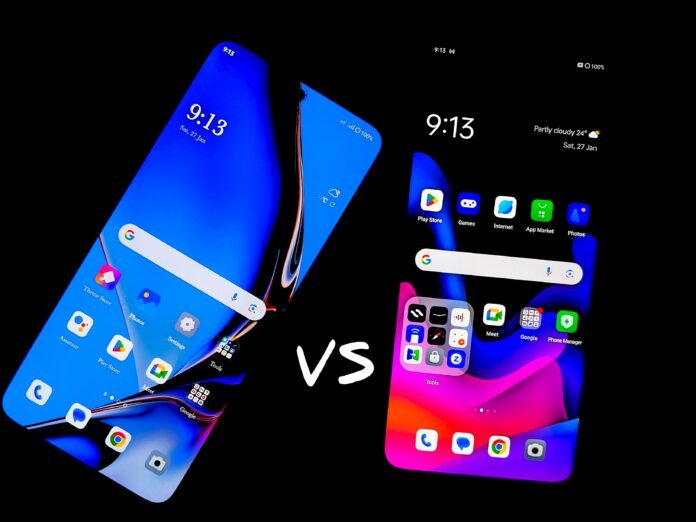In the world of modern electronics, whether it’s smartphones, televisions, or monitors, the type of screen used plays a crucial role in the overall viewing experience. Three of the most commonly discussed screen technologies are OLED, AMOLED, and LCD. Each of these technologies has its unique characteristics, advantages, and drawbacks. But what exactly are the differences between them, and how do they impact the way we use our devices?
This article will break down the key differences between OLED, AMOLED, and LCD screens, helping you understand how each works and which one might be best suited for your needs.
LCD Screens: The Traditional Workhorse
LCD stands for Liquid Crystal Display, and it has been the go-to screen technology for many years. The technology behind LCD screens involves liquid crystals that align to let light pass through or block it. However, these liquid crystals don’t produce light on their own. Instead, they rely on a backlight, usually made of LED (Light Emitting Diode) lights, to illuminate the screen.
How LCD Works:
In an LCD screen, the liquid crystals are arranged in a grid of cells. Each cell can adjust its orientation based on the input signal from the device, allowing varying amounts of light to pass through the color filters. This manipulation of light creates the image on the screen. The backlight, which is positioned behind the liquid crystals, provides a uniform light source to brighten the display.
Advantages of LCD:
- Cost-Effective: LCD screens are generally less expensive to produce, making them the most common screen type in lower-cost devices.
- Energy-Efficient: LCDs, particularly those with LED backlighting, consume relatively low amounts of power compared to older technologies like CRT (Cathode Ray Tube) displays.
- Wide Availability: LCD screens are used in everything from budget smartphones and televisions to computer monitors, making them widely available.
Drawbacks of LCD:
- Limited Black Levels: Because LCDs rely on a backlight, they struggle to display true black. The backlight bleeds through, causing dark areas of the screen to appear as deep gray rather than pure black.
- Less Vibrant Colors: The color reproduction on an LCD screen is not as rich or vibrant as that on OLED or AMOLED displays.
- Viewing Angles: LCD screens tend to lose brightness and color accuracy when viewed from an angle, making them less ideal for group viewing.
OLED Screens: Organic Light Emitting Diodes
OLED stands for Organic Light Emitting Diode. Unlike LCD technology, OLED displays do not require a backlight. Instead, each pixel in an OLED display is made up of an organic compound that emits its own light when an electric current is applied. This means each individual pixel can turn on or off independently, allowing OLED screens to display true blacks and vibrant colors with exceptional contrast ratios.
How OLED Works:
An OLED screen uses a layer of organic materials that emit light when an electrical current passes through them. These materials are placed between two electrodes: an anode and a cathode. The organic material generates light on its own, meaning there is no need for a separate backlight. This results in a more efficient and more flexible display technology, as each pixel can control its own light output.
Advantages of OLED:
- True Black Levels: Since each pixel emits its own light, OLED screens can completely turn off individual pixels, resulting in perfect black levels. This leads to exceptional contrast, especially in dark scenes.
- Vibrant Colors: OLED displays produce rich, saturated colors that make images pop, providing a more immersive viewing experience.
- Thin and Flexible: OLED screens are incredibly thin because they don’t require a backlight. This allows manufacturers to create sleek, curved, and even foldable displays.
- Faster Response Times: OLED technology has faster refresh rates and response times compared to LCD, making it ideal for gaming and fast-moving video content.
Drawbacks of OLED:
- Burn-In: One of the major drawbacks of OLED screens is the potential for “burn-in,” a phenomenon where static images or content displayed for extended periods can leave a permanent ghost image on the screen.
- Expensive: OLED screens are generally more expensive to produce than LCD displays, which means they are found on higher-end devices, such as flagship smartphones and premium TVs.
- Shorter Lifespan: The organic materials used in OLED displays can degrade over time, which may lead to a shorter lifespan compared to LCD screens, particularly in the blue pixels.
AMOLED Screens: Active Matrix OLED
AMOLED stands for Active Matrix Organic Light Emitting Diode. This technology is a type of OLED display, but it uses a different method of controlling the individual pixels. The “active matrix” part of the name refers to the way pixels are addressed. AMOLED screens use thin-film transistors (TFTs) to control each pixel individually, making them more efficient at handling large displays and ensuring quicker refresh rates. This makes AMOLED screens particularly popular in smartphones and other portable devices.
How AMOLED Works:
AMOLED displays are similar to OLED in that each pixel produces its own light, but AMOLED screens use an additional layer of thin-film transistors (TFTs) to address and activate individual pixels. This matrix of transistors ensures that each pixel turns on and off quickly and precisely, which allows for smoother transitions between colors and faster response times.
Advantages of AMOLED:
- Superior Contrast and Black Levels: Like OLED, AMOLED screens can achieve true blacks since each pixel is independently lit and can be turned off completely.
- Lower Power Consumption: AMOLED screens are more power-efficient than traditional LCDs, especially when displaying dark images or black content because the pixels do not need to be lit up.
- Slim Form Factor: AMOLED screens can be incredibly thin, which allows for sleek device designs and even curved displays.
- Faster Refresh Rates: AMOLED screens are optimized for high refresh rates, making them excellent for gaming and high-definition video content.
Drawbacks of AMOLED:
- Expensive: Like OLED, AMOLED screens are more costly to produce, which means they are often found on high-end smartphones and premium devices.
- Burn-In Risk: AMOLED screens share the same risk of burn-in as OLED, meaning that static images can leave a permanent mark on the screen if left for too long.
- Brightness Issues in Direct Sunlight: While AMOLED screens are generally bright, they may struggle to achieve the same level of brightness as high-quality LCDs, particularly in bright outdoor conditions.
OLED vs. AMOLED vs. LCD: A Quick Comparison
| Feature | LCD | OLED | AMOLED |
|---|---|---|---|
| Backlight | Requires backlight | No backlight needed | No backlight needed |
| Black Levels | Poor (gray instead of black) | True black | True black |
| Color Accuracy | Moderate | Excellent | Excellent |
| Power Consumption | Higher (due to backlight) | Lower (variable power) | Lower (variable power) |
| Cost | Low | High | High |
| Viewing Angles | Narrower angles | Wide angles | Wide angles |
| Thickness | Thicker | Very thin | Very thin |
| Lifespan | Long | Moderate (blue pixel wear) | Moderate (burn-in risk) |
Conclusion
When choosing a display technology, it ultimately depends on the type of experience you want and your budget. LCD screens are an affordable and widely available option with decent quality but limitations in color and black levels. OLED offers stunning visuals with true blacks and vibrant colors, making it ideal for high-end devices, though it comes with a higher price tag and potential burn-in concerns. AMOLED, an enhanced version of OLED, takes it a step further with faster refresh rates and power efficiency, especially suited for smartphones and devices that require quick responses.
Each of these technologies has its place in the market, and understanding their differences can help you make a more informed choice when purchasing your next device. Whether you’re watching movies, playing games, or just browsing your smartphone, the choice of display will directly impact your experience.

